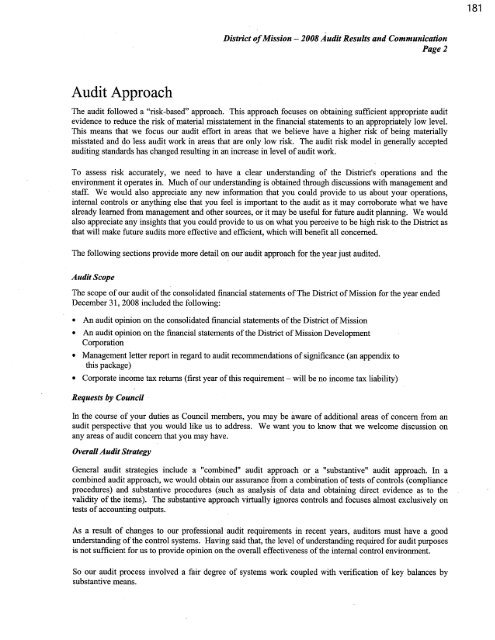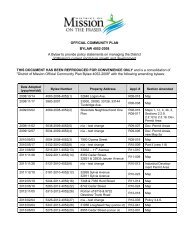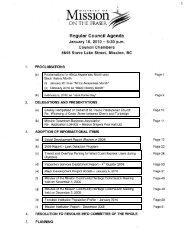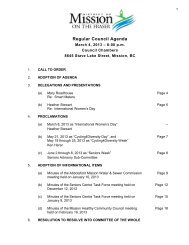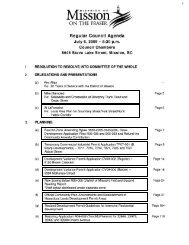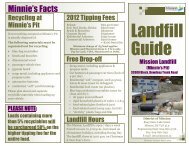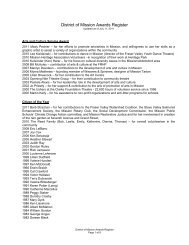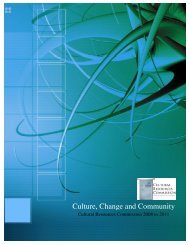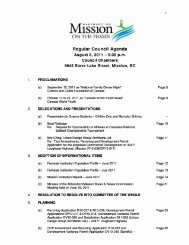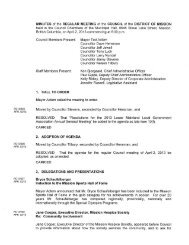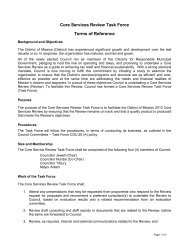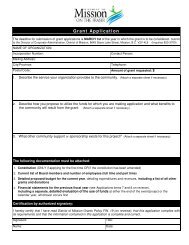June 15, 2009 - District of Mission
June 15, 2009 - District of Mission
June 15, 2009 - District of Mission
You also want an ePaper? Increase the reach of your titles
YUMPU automatically turns print PDFs into web optimized ePapers that Google loves.
181<br />
<strong>District</strong> <strong>of</strong> <strong>Mission</strong> — 2008 Audit Results and Communication<br />
Page 2<br />
Audit Approach<br />
The audit followed a "risk-based" approach. This approach focuses on obtaining sufficient appropriate audit<br />
evidence to reduce the risk <strong>of</strong> material misstatement in the financial statements to an appropriately low level.<br />
This means that we focus our audit effort in areas that we believe have a higher risk <strong>of</strong> being materially<br />
misstated and do less audit work in areas that are only low risk. The audit risk model in generally accepted<br />
auditing standards has changed resulting in an increase in level <strong>of</strong> audit work.<br />
To assess risk accurately, we need to have a clear understanding <strong>of</strong> the <strong>District</strong>'s operations and the<br />
environment it operates in. Much <strong>of</strong> our understanding is obtained through discussions with management and<br />
staff. We would also appreciate any new information that you could provide to us about your operations,<br />
internal controls or anything else that you feel is important to the audit as it may corroborate what we have<br />
already learned from management and other sources, or it may be useful for future audit planning. We would<br />
also appreciate any insights that you could provide to us on what you perceive to be high risk to the <strong>District</strong> as<br />
that will make future audits more effective and efficient, which will benefit all concerned.<br />
The following sections provide more detail on our audit approach for the year just audited.<br />
Audit Scope<br />
The scope <strong>of</strong> our audit <strong>of</strong> the consolidated financial statements <strong>of</strong> The <strong>District</strong> <strong>of</strong> <strong>Mission</strong> for the year ended<br />
December 31, 2008 included the following:<br />
• An audit opinion on the consolidated financial statements <strong>of</strong> the <strong>District</strong> <strong>of</strong> <strong>Mission</strong><br />
• An audit opinion on the financial statements <strong>of</strong> the <strong>District</strong> <strong>of</strong> <strong>Mission</strong> Development<br />
Corporation<br />
• Management letter report in regard to audit recommendations <strong>of</strong> significance (an appendix to<br />
this package)<br />
• Corporate income tax returns (first year <strong>of</strong> this requirement — will be no income tax liability)<br />
Requests by Council<br />
In the course <strong>of</strong> your duties as Council members, you may be aware <strong>of</strong> additional areas <strong>of</strong> concern from an<br />
audit perspective that you would like us to address. We want you to know that we welcome discussion on<br />
any areas <strong>of</strong> audit concern that you may have.<br />
Overall Audit Strategy<br />
General audit strategies include a "combined" audit approach or a "substantive" audit approach. In a<br />
combined audit approach, we would obtain our assurance from a combination <strong>of</strong> tests <strong>of</strong> controls (compliance<br />
procedures) and substantive procedures (such as analysis <strong>of</strong> data and obtaining direct evidence as to the<br />
validity <strong>of</strong> the items). The substantive approach virtually ignores controls and focuses almost exclusively on<br />
tests <strong>of</strong> accounting outputs.<br />
As a result <strong>of</strong> changes to our pr<strong>of</strong>essional audit requirements in recent years, auditors must have a good<br />
understanding <strong>of</strong> the control systems. Having said that, the level <strong>of</strong> understanding required for audit purposes<br />
is not sufficient for us to provide opinion on the overall effectiveness <strong>of</strong> the internal control environment.<br />
So our audit process involved a fair degree <strong>of</strong> systems work coupled with verification <strong>of</strong> key balances by<br />
substantive means.


